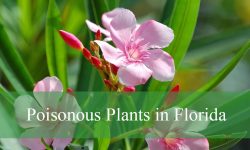Purple flower vines add a touch of elegance and charm to gardens, landscapes, and outdoor spaces. These enchanting climbers not only provide beautiful blooms but also enhance the overall aesthetic of your surroundings. In this article, we’ll explore 21 stunning types of purple flower vines, accompanied by vibrant pictures to help you envision their beauty in your own garden.
Blue Sky Vine (Thunbergia grandiflora)
The Blue Sky Vine, scientifically known as Thunbergia grandiflora, is a captivating botanical specimen with a fascinating profile. This perennial beauty thrives in specific zones, primarily zones 8 and 9, although it can also be grown as an annual in other regions. Native to the enchanting landscapes of India and South Asia, it carries with it a rich heritage of exotic allure.
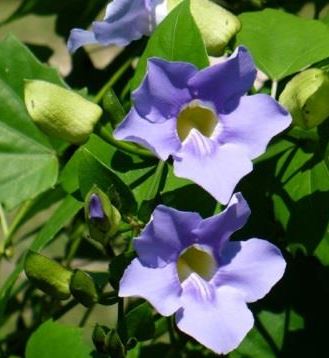
In terms of size, the Blue Sky Vine can truly make a statement in your garden, reaching heights of 15 to 30 feet when given the right conditions. When it comes to sunlight preferences, it is quite versatile, thriving in full sun, partial sun, or even partial shade, making it adaptable to a variety of garden settings. Its ability to flourish within the hardiness zones of 8 to 11 further enhances its appeal and makes it a viable choice for many gardeners.
Purple Bougainvillea Vine
Purple Bougainvillea Vine, also known by its scientific name Bougainvillea spectabilis, is a stunning plant that can be either perennial or annual depending on the climate. Originally from Brazil, this vine can reach an impressive height of 15 to 40 feet. It thrives in full sun and is best suited for planting in zones 9-11.
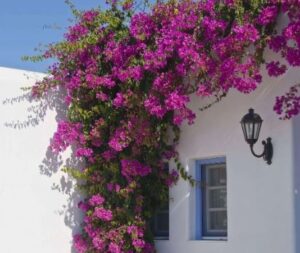
The brilliant hues produced by the Bougainvillea vine include orange, crimson, and of course, purple. Although the Bougainvillea’s actual blooms are tiny and white, the bracts that surround them, which are essentially huge modified leaves, add magnificent color.
The Bougainvillea is a dense, woody vine that blooms in the early spring and continues until the fall. For any gardener who enjoys the color purple, the Bougainvillea is a wise investment because it produces one of the most beautiful purple vines.
Purple Clematis Vine
The Purple Clematis Vine, scientifically known as Clematis viticella, is a perennial plant that boasts its elegance and charm. Originating from diverse regions including China, Japan, and Europe, this vine graces gardens with its presence.
Standing at a height of 10 to 15 feet, the Purple Clematis Vine creates a captivating vertical display, adding a touch of grace and beauty to outdoor spaces.
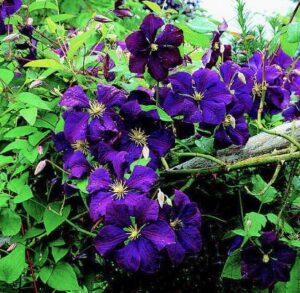
With a plant hardiness zone of 4, it can withstand a range of climates, making it a resilient addition to your garden. Star-shaped blossoms on the Clematis, a purple flowering vine, typically open in the middle of July. Tendrils on the clematis are used to climb any surface that is accessible, including poles, walls, trellises, and metal fences.
The Clematis is one of the most resilient climbing vines, and it grows swiftly and prospers even in regions with lower temperatures. Despite having Chinese and Japanese origins, this plant is also frequently seen in England. The number of clematis varieties exceeds 300, making it an extremely adaptable vine.
Dutchman’s Pipe
The Dutchman’s Pipe, scientifically known as Aristolochia gigantea, is a perennial plant with roots in North America. This remarkable vine can grow to heights of 15 to 30 feet, making it a striking addition to any garden.
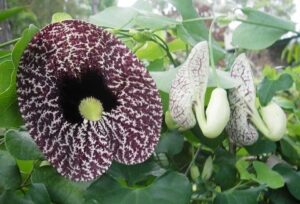
With a recommended plant zone of 10-12, it’s well-suited for regions with mild to tropical climates. Dutchman’s Pipe is a distinctive option that can make your garden stand out, even though it is not the first pick for many gardeners seeking for climbing vines with purple blooms. The flower’s lobes and overall design are described as “Dutchman’s Pipe” because they resemble a Dutch smoking pipe.
The flower has a greenish-yellow color, and there are two to three dark maroon-purple lobes encircling it. Dutchman’s Pipe does not thrive in drier soils and likes damp soil.
Hyacinth Bean Vine
The Hyacinth Bean Vine, scientifically known as Lablab purpureus, is an annual plant with its roots in Africa and Asia. This vibrant vine can grow to heights of 10 to 15 feet, making it a striking addition to gardens.
With a recommended plant zone of 10-11, it’s ideally suited for tropical and subtropical regions.
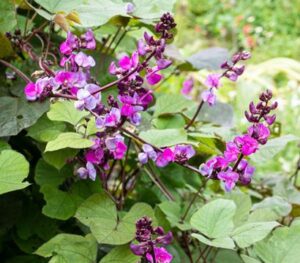
The thick and compact Hyacinth Bean Vine produces burgundy stems with light purple bracts. The bean pods are distinct because they are a striking deep purple, and the leaves are broad and shaded.
Hyacinth Bean Vine Older or dried beans are poisonous, despite the fact that the plant’s young blossoms are edible. This vine might not be for you if you want non-poisonous vines in your yard.
Lavender Trumpet Vine
The Lavender Trumpet Vine, scientifically known as Clytostoma callistegioides, hails from the vibrant landscapes of Brazil. This perennial beauty graces gardens with its presence, showcasing its elegance and charm.
With an impressive height ranging from 15 to 20 feet, the Lavender Trumpet Vine creates a stunning vertical display that captures attention. It thrives under the warm glow of full sun but can also tolerate partial shade, offering flexibility in garden placement.
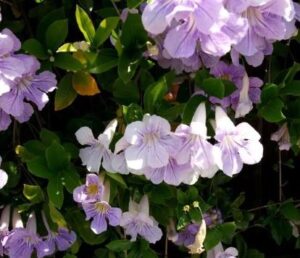
Adaptable to a wide range of climates, the Lavender Trumpet Vine thrives in plant hardiness zones 4 to 10, making it a versatile choice for various regions. This exquisite plant not only adds a burst of lavender-colored beauty to your outdoor space but also carries a touch of Brazil’s natural heritage, connecting your garden to distant lands.
The Lavender Trumpet Vine is a woody vine with thick foliage and blossoms that resemble what its name implies. These three-inch-wide flowers have a trumpet-like shape, and their delicate purple coloring gives your garden a lovely pastel tone.
Morning Glory
The Morning Glory, scientifically known as Ipomoea purpurea, is a charming and versatile plant. Originating from the vibrant landscapes of Mexico and Central America, it brings a touch of exotic beauty to gardens around the world.
This plant exhibits flexibility in its lifespan, acting as a perennial in zones 9-11 and an annual in other regions. With a potential height of 6 to 10 feet, the Morning Glory creates a vertical garden that’s truly enchanting.
Thriving under the warm embrace of full sun, it displays its full splendor when bathed in sunlight. With a wide plant zone range spanning from 2 to 11, it can adapt to various climates, making it suitable for a variety of garden settings.
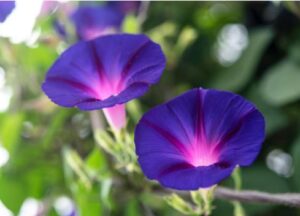
The Morning Glory vine gets its name from the way it blooms every morning; its blossoms open in the morning and close at night. Because there are so many varieties of morning glory, it is a plant with many uses.
The flowers have a wide trumpet shape with a diameter of one to two inches. Sometimes the purple color is combined with blue to produce colors of indigo or deep purple. Each blossom has a design that looks like a star when viewed from the front.
Morning glory plants are potentially invasive since they frequently self-seed and are drought-resistant. You can confine your Morning Glory vine to a single region of your garden with careful management. Keep dogs and children away from the seeds because they are harmful as well.
Nightshade
The Nightshade, scientifically known as Solanum xanti, is a hardy perennial plant native to North America. With a modest height of around 8 feet, it offers a versatile and elegant presence in gardens.
One of its remarkable features is its adaptability to varying light conditions. The Nightshade can thrive under full sun, partial shade, or even in full shade, making it a suitable choice for a wide range of garden settings.

Recommended for plant hardiness zones 7 to 10, the Nightshade demonstrates its resilience in these regions, adding natural beauty to landscapes. With its North American origins, this perennial plant is a testament to the diversity and charm of the continent’s native flora. Whether in sunny spots or shaded corners, the Nightshade graces gardens with its enduring and adaptable presence.
Purple Flowering Passion Vines
The Passion Vine, scientifically known as Passiflora, is a captivating perennial plant with origins in the diverse landscapes of Central, North, and South America. Its growth can range from a modest 6 feet to an impressive 30 feet, making it a versatile and striking addition to gardens.
This plant thrives under various light conditions, from full sun to partial shade, offering flexibility in garden placement. It’s recommended for plant hardiness zones 6 to 10, showcasing its adaptability to a range of climates.
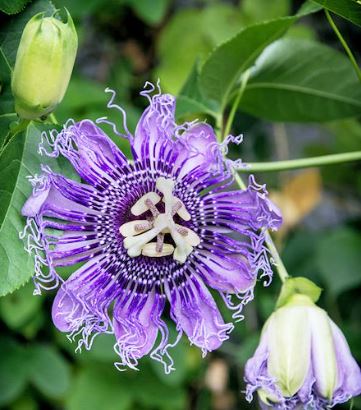
Radial filaments, ten petals, and three stigma make the blossoms of the passion vine unique. The radial threads, in example, are frequently pale purple or blue, though they can be any hue.
The amazing and exceptional flower known as the passionflower, which bears Christ’s name, blooms on the Passion Vine. Most kinds will also yield passionfruit, however these are frequently decorative.
Twining Snapdragon
The Twining Snapdragon, scientifically known as Antirrhinum kelloggii, is an annual plant native to the beautiful landscapes of North America. Despite its relatively small stature, typically growing between 1 to 3 feet in height, it carries a unique charm that enchants garden enthusiasts.
This delightful plant thrives under a range of light conditions, from full sun to partial shade, making it a flexible choice for various garden settings. It’s best suited for plant hardiness zones 9 to 10, showcasing its adaptability to mild and warm climates.
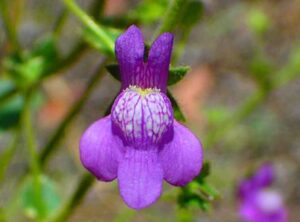
The indigo or deep purple blossoms of the Twining Snapdragon may have blue or white highlights. This plant is lower in stature because to its slender, clinging stalks. The Twining Snapdragon is a fantastic alternative to denser or woodier plants if you don’t have a trellis or other comparable structure for a climbing vine.
Purple Flowering Wisteria Vine
Wisteria, bearing its simple yet evocative scientific name, is a perennial wonder that traces its origins to the enchanting regions of Asia, North America, and Iran. This remarkable vine can grow to impressive heights, ranging from 30 to 60 feet, creating a breathtaking vertical display in gardens.
Wisteria’s adaptability shines through its ability to thrive in both full sun and partial shade, making it a versatile choice for various outdoor spaces. It’s best suited for plant hardiness zones 5 to 9, showcasing its resilience in a range of climates.
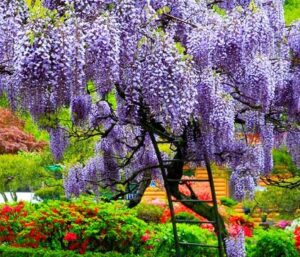
A woody twining vine with lavender blooms hanging from it is called wisteria. Wisteria needs a strong support in order to grow because its vine twines. Wisteria can be controlled so that it grows robust and attractively by careful pruning.
When wisteria is in bloom, the blossoms have several little flowers grouped together along the vine, giving them the appearance of a cone brush. The hanging blooms often retain their purple color, however they occasionally display blue, pink, or white tones. Wisteria is typically known to grow very well in the sun, however depending on your hardiness zone, they can also make an excellent option as a vine in shadow gardens.
Purple Climbing Roses
Climbing roses with long, woody stems that can be trained to climb are known as vining roses. Throughout the summer, the lovely purple, light pink, or lilac rose blossoms bloom, providing vibrant height accents to your garden’s scenery. Growing purple climbing roses over arbors or gate entries will enhance the beauty of your yard.
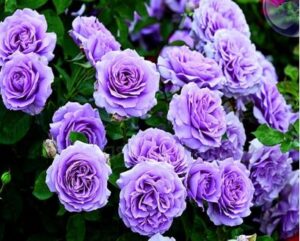
As the canes grow, support them to encourage the roses to climb. The tall, slender stems, sometimes known as canes, can reach heights of 10 feet (3 meters). In USDA zones 5 through 9, place climbing roses in full light to ensure their success. Summertime water levels are high enough to prevent the soil from fully aerating.
Mandevilla Vine with Purple Flowers
Large, funnel-shaped flowers in various hues of purple, red, white, and pink are produced by the tropical vining plant known as Mandevilla. The vine is ideal for climbing up and over fences, trellises, or pergolas. Mandevilla vines thrive in evergreen hedges or privacy screens and produce blooms all season long.
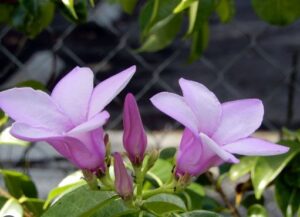
As a tropical climbing vine, Mandevilla grows as an annual in colder climates. As long as it receives direct sunlight, you can plant the quickly growing creeper in garden beds or borders. To enjoy its purple flowers indoors, you may also cultivate this trailing plant in a hanging basket.
Japanese Honeysuckle (Lonicera japonica ‘Purpurea’)
Additionally known as Purple-Leaf Japanese honeysuckle is a tough climbing vine with twining stems, luxuriant dark-green leaves, and fragrant purple-red blooms. Japanese Honeysuckle grows quickly and is perfect for draping over an arbor or setting up as a privacy screen. Without assistance, you can allow the creeping vine to cover any bare patches of land.
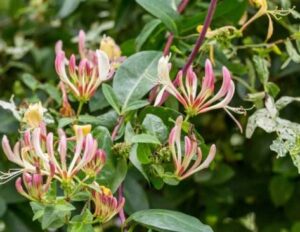
For partial shade in zones 4 through 11, Japanese honeysuckle is an exotic climbing plant that can be either semi-evergreen or evergreen. You must prune the vines before winter in cooler climates. The flowering vine reaches heights of 10 to 30 feet (3 to 9 meters).
Climbing Nasturtium (Tropaeolum ‘Purple Emperor’)
Climbing Nasturtium features broad, light-green foliage and creeping vines with purple, rose-like blooms. Nasturtium’s twining stems will scale trellises, arbors, mailbox posts, and chain fences. In addition to the ‘Purple Emperor’ variety’s pale purple blossoms, Nasturtium varieties also produce flowers that are bright yellow, vivid crimson, and bright orange.
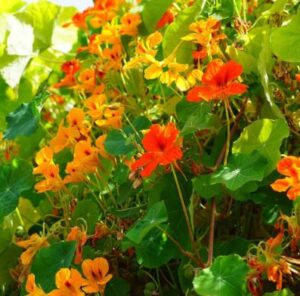
Growing as a tough annual is climbing Nasturtium. Nasturtium is a ground-based plant that may be grown in USDA zones 7 through 10. This floral vine only grows as an annual in cooler regions.
Boston Ivy (Parthenocissus tricuspidata)
Boston ivy is a robust clinging vine with reddish-purple to purple foliage and unnoticeable blooms. Boston ivy isn’t a kind of climbing plant that remains purple all year round. Some varieties of Boston ivy have foliage that is initially purple, then changes to green in the summer, and finally becomes crimson red in the fall.
Boston Ivy contains traditional ivy-shaped leaves that change color throughout the year. Purple berries start to ripen after the ivy blooms, but you won’t notice them until the climbing deciduous vine has lost all of its leaves.
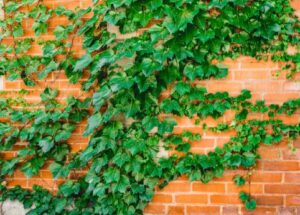
Thanks to its sucker vines, Boston Ivy can reach incredible heights. The tall vine can frequently grow as tall as 50 feet (15 meters).
Sweet Pea (Lathyrus odoratus)
An attractive annual climbing vine with flowers in purple, pink, orange, red, and lilac hues is the Sweet Pea. Sweet pea climbing plants can reach heights of 6 to 8 feet (1.8 – 2.4 m), depending on the cultivar. The tiny stems need to be intertwined or supported in order for them to climb high.
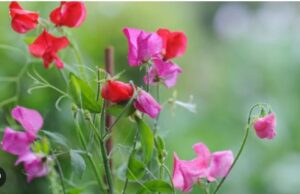
Grow the flowering vines in full light if you want to take advantage of the abundance of Sweet Pea flower clusters and their lovely scents. The sweet pea blooms from spring through fall and grows best in moderate regions.
Climbing Fuchsia
With purple, pink, and red flowers, many Fuchsia types are shrubby climbing vines. A robust climber with bell-shaped flowers in shades of purple-pink or purple-red, fuchsia blooms from spring to fall. The leaves of the fuchsia vine are oval, dark green, and have serrated edges.
The soil should be moist but well-draining for fuchsia varieties, some of which are more sun-tolerant than others. A mature climbing fuchsia plant can grow up to 10 feet (3 meters) tall and up to 5 feet (1.5 meters) tall in a single season. USDA zones 9 to 11 are ideal for growing hardy fuchsias.
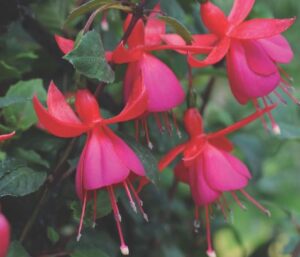
The ornamental purple vining fuchsia plants look great as back-of-border plantings and are also useful for hiding trellises and chain-link fences and creating a flowery privacy screen. As a flowering hanging basket plant, you can also grow certain fuchsia species.
Butterfly Pea (Centrosema molle)
Climbing plants called “butterfly peas” feature blossoms with beautiful pale violet petals and deep purple veins. Butterfly Pea should be grown as part of a summer hedgerow that is blossoming since the delicate stems need assistance to develop upward. Annual butterfly pea vines can reach heights of up to 18″ (45 cm).

Garlic Vine (Mansoa alliacea)
Elegant purple to light lilac flowers are produced by garlic vine, a climbing plant. Garlic is an evergreen decorative creeping plant that can reach heights of up to 8 feet (2.5 meters). The flowers on the purple garlic vine appear twice a year. Additionally, crushing the leaves releases a garlic-like smell.
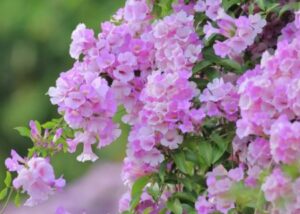
In zones 9 and higher, garlic vines can be seen growing underground. If they receive enough sunlight to bloom, garlic vines can also be grown inside in containers.
Chocolate Vine (Akebia quinata)
A woody climbing plant with brownish-purple flowers and broad, palmately complex leaves, the chocolate vine is deciduous. Early spring marks the appearance of the purple blossoms on the vine. This fast-growing woody vine, also known as the Five-Leaf Akebia, has purple fruit that resembles a sausage.
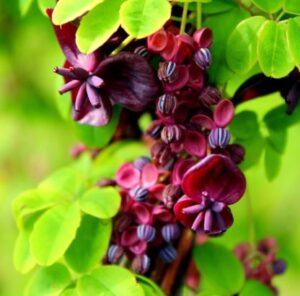
In USDA zones 5 through 8, chocolate vines reach heights of 25 to 60 feet (7.5 to 18 meters) and flourish in full light.
Conclusion
Whether you’re looking to cover a trellis, fence, or pergola, these 21 types of purple flower vines provide a wide range of options to elevate your garden’s beauty. With the accompanying pictures, you can easily choose the perfect purple flower vine to enhance your outdoor space and enjoy the visual splendor it brings.

